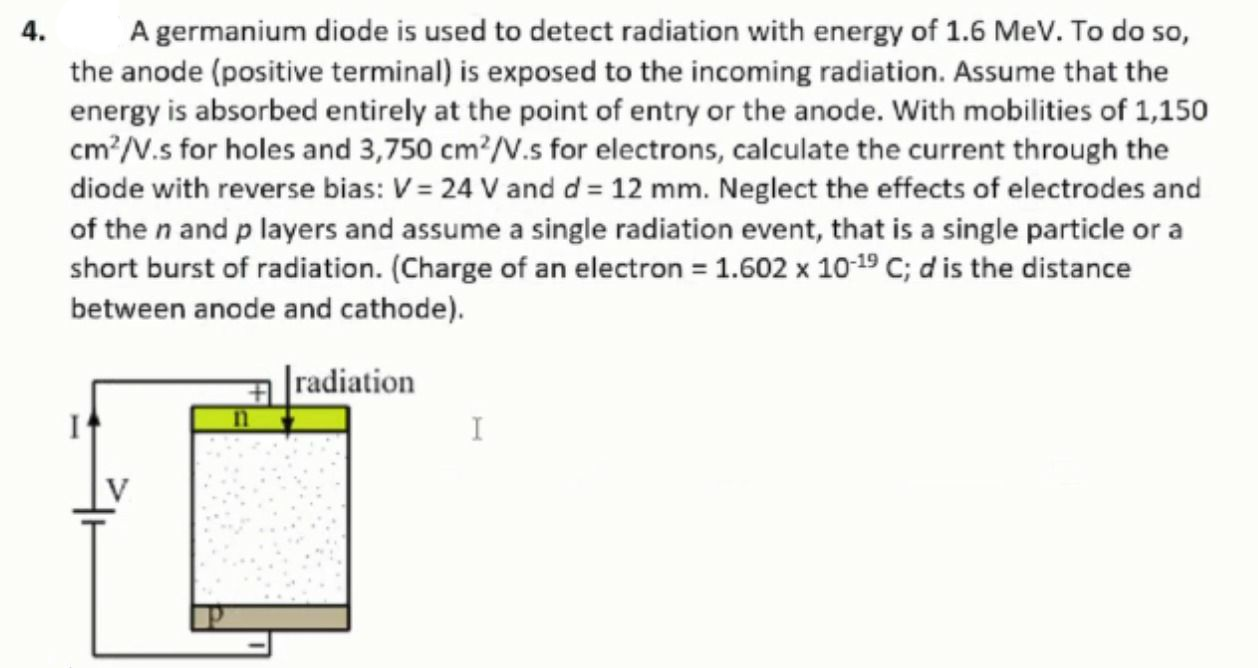A germanium diode is used to detect radiation with energy of 1.6 MeV. To do so, the anode (positive terminal) is exposed to the incoming radiation. Assume that the energy is absorbed entirely at the point of entry or the anode. With mobilities of 1,150 cm?/V.s for holes and 3,750 cm?/V.s for electrons, calculate the current through the diode with reverse bias: V = 24 V and d = 12 mm. Neglect the effects of electrodes and 4. of the n and p layers and assume a single radiation event, that is a single particle or a short burst of radiation. (Charge of an electron = 1.602 x 10-19 C; d is the distance between anode and cathode).
A germanium diode is used to detect radiation with energy of 1.6 MeV. To do so, the anode (positive terminal) is exposed to the incoming radiation. Assume that the energy is absorbed entirely at the point of entry or the anode. With mobilities of 1,150 cm?/V.s for holes and 3,750 cm?/V.s for electrons, calculate the current through the diode with reverse bias: V = 24 V and d = 12 mm. Neglect the effects of electrodes and 4. of the n and p layers and assume a single radiation event, that is a single particle or a short burst of radiation. (Charge of an electron = 1.602 x 10-19 C; d is the distance between anode and cathode).
Modern Physics
3rd Edition
ISBN:9781111794378
Author:Raymond A. Serway, Clement J. Moses, Curt A. Moyer
Publisher:Raymond A. Serway, Clement J. Moses, Curt A. Moyer
Chapter14: Nuclear Physics Applications
Section: Chapter Questions
Problem 15P
Related questions
Question

Transcribed Image Text:A germanium diode is used to detect radiation with energy of 1.6 MeV. To do so,
the anode (positive terminal) is exposed to the incoming radiation. Assume that the
energy is absorbed entirely at the point of entry or the anode. With mobilities of 1,150
cm?/V.s for holes and 3,750 cm?/V.s for electrons, calculate the current through the
diode with reverse bias: V = 24 V and d = 12 mm. Neglect the effects of electrodes and
4.
of the n and p layers and assume a single radiation event, that is a single particle or a
short burst of radiation. (Charge of an electron = 1.602 x 10-19 C; d is the distance
between anode and cathode).
Expert Solution
This question has been solved!
Explore an expertly crafted, step-by-step solution for a thorough understanding of key concepts.
This is a popular solution!
Trending now
This is a popular solution!
Step by step
Solved in 2 steps with 2 images

Knowledge Booster
Learn more about
Need a deep-dive on the concept behind this application? Look no further. Learn more about this topic, physics and related others by exploring similar questions and additional content below.Recommended textbooks for you

Modern Physics
Physics
ISBN:
9781111794378
Author:
Raymond A. Serway, Clement J. Moses, Curt A. Moyer
Publisher:
Cengage Learning


Glencoe Physics: Principles and Problems, Student…
Physics
ISBN:
9780078807213
Author:
Paul W. Zitzewitz
Publisher:
Glencoe/McGraw-Hill

Modern Physics
Physics
ISBN:
9781111794378
Author:
Raymond A. Serway, Clement J. Moses, Curt A. Moyer
Publisher:
Cengage Learning


Glencoe Physics: Principles and Problems, Student…
Physics
ISBN:
9780078807213
Author:
Paul W. Zitzewitz
Publisher:
Glencoe/McGraw-Hill

University Physics Volume 3
Physics
ISBN:
9781938168185
Author:
William Moebs, Jeff Sanny
Publisher:
OpenStax